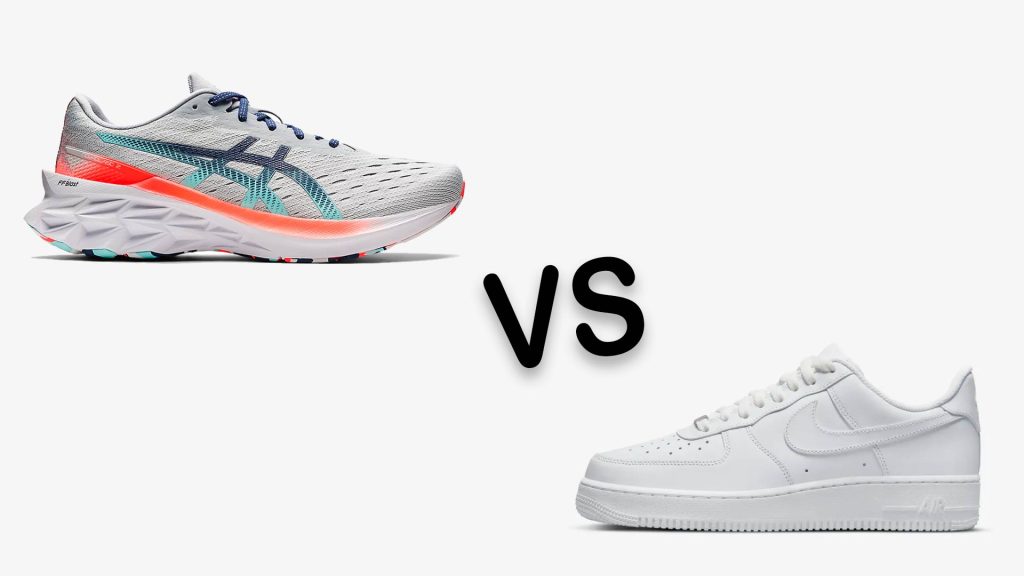Estimated read time: 5 minutes.
Do you know the difference between running shoes and sneakers? Most people think they are the same, but there is a big difference! In this blog post, we will discuss the differences between running shoes and sneakers and why it is important to choose the right type of shoe for your needs.
What Are the differences between running shoes and sneakers?
The main difference between running shoes and sneakers is the purpose for which they are each designed. Running shoes are specifically for running, while sneakers are for general everyday use. This means running shoes will have certain features that sneakers do not, and vice versa.
One of the most important differences between running shoes and sneakers is the type of sole. Running shoes generally have a more cushioned sole than sneakers. This helps to protect your feet from the impact of running and can help to prevent injuries. The soles of sneakers are not as cushioned as those of running shoes, which makes them better suited for activities such as walking.
Running shoes are also generally more lightweight than sneakers. This is because they need to be easy to move in and should not weigh you down when running.
What Are Sneakers?
Sneakers come in a variety of shapes, sizes, and colors. They are designed to be comfortable and provide support for your feet while doing everyday activities such as walking or running errands. The term “sneaker” is often used interchangeably with “tennis shoe” or “trainer.”
Sneakers are usually meant to wear casually. In the past, sneakers were only meant for physical activities like playing tennis or running. However, nowadays, people often wear sneakers as everyday shoes because they are comfortable.
Wearing sneakers with the wrong outfit can sometimes ruin the look, so it is important to keep this in mind when choosing an outfit for the day. A popular combination is blue jeans, a white tee-shirt, and a white pair of sneakers.
Sneakers are more popular among younger people, but people of all ages can wear them. Sneakers can feel a bit heavy and hot in the summer due to thick and non-absorbent materials, so many people prefer to wear sandals or flip-flops when the weather is warm.
The most popular brands of sneakers are Nike, Adidas, Puma, and Converse. The material of the sneaker, as well as the style, often dictates the price. For example, a pair of Nike sneakers made with leather will be more expensive than a pair of Adidas sneakers made with synthetic materials.
What Are Running Shoes?
Running shoes, a.k.a sports shoes, are designed to provide support and comfort while running. They come in various shapes, sizes, and colors to fit every runner’s needs. The most important thing to consider when choosing running shoes is the type of support they offer.
There are three main types of support: motion control, stability, and cushioning. Motion control shoes are meant for runners with flat feet or low arches. Stability shoes are meant for runners who have high arches or need extra support in the arch area. Cushioning shoes are meant for runners who need extra shock absorption in the heel and forefoot areas.
Sports shoes are made with various materials, such as breathable knit Polyester or Nylon mesh, to allow your feet to breathe and stay cool while running. Running shoe uppers often have reflective materials to increase your visibility in low-light conditions.
The soles of running shoes are usually made from carbon rubber, blown rubber, or a combination of both. Carbon rubber is durable and gives good traction, while blown rubber is lighter and more flexible. The type of sole you need depends on your running surface. For example, if you are running on pavement, you will need a different sole than running on trails.
The most popular brands of running shoes are Nike, Adidas, Asics, Brooks, and Saucony. Just like with sneakers, the price of running shoes depends on the brand, materials used, and the style of the shoe.
When choosing running shoes, it is important to go to a store specializing in sports gear and talk to a salesperson who can help you find the right shoe for your foot type and running style.
It is also important to break in your shoes before you go for a long run by wearing them around the house or on short runs. This will help prevent blisters and other problems.
It is important to replace your running shoes every 300-500 miles, depending on how often you use them. Running in old or worn-out shoes can lead to injuries such as shin splints, Achilles tendonitis, and plantar fasciitis.
Conclusion
So, what’s the difference between running shoes and sneakers? Running shoes are designed for support and comfort while running, while sneakers can be worn for casual activities or everyday wear.
The most important thing to consider when choosing running shoes is the type of support they offer, while the style is more important when choosing sneakers. Both shoes come in various brands, materials, and styles to fit every person’s needs.
It is important to replace your running shoes every 300-500 miles and your sneakers as needed to prevent injuries. So now that you know the difference between these two types of shoes go out and get yourself a pair (or two) of each!
FAQ About Running Shoes vs Sneakers
- How Many Laps Around a Track is a 5K: Your Guide - October 22, 2023
- When is Track and Field Season? - October 22, 2023
- Understanding the Length: How Long Is a Running Track? - October 22, 2023




